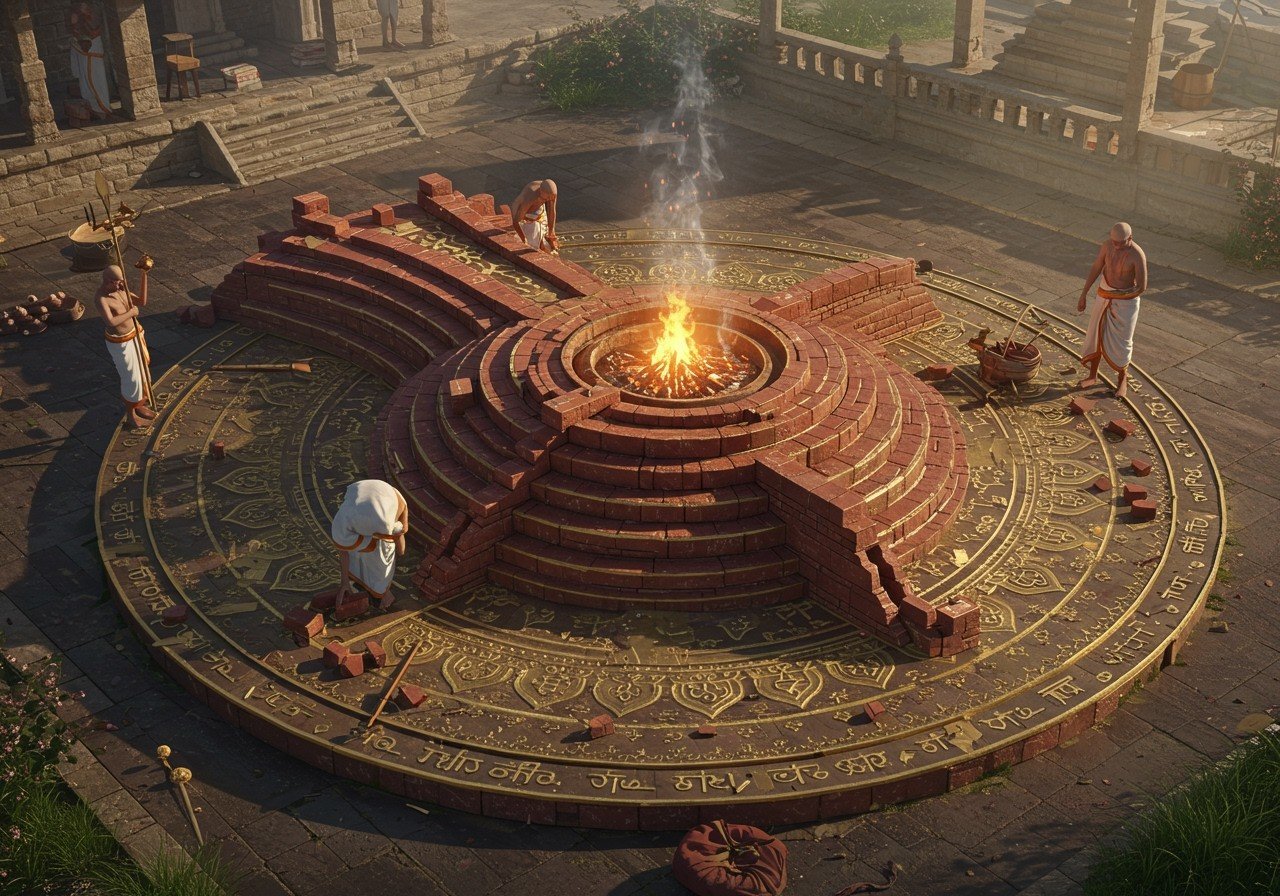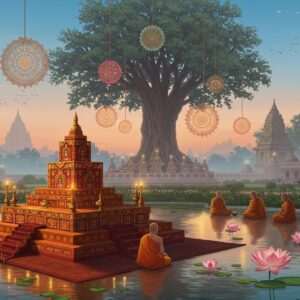
The Agnicayana ritual holds a special place in the heart of Vedic traditions. This sacred ceremony, centered around the intricate construction of the Agnicayana altar, is a testament to India’s rich cultural and spiritual tapestry. This guide delves into the profound process of building this altar, harmonizing ancient rituals with the realities of our modern lives. Before we begin, let’s appreciate the historical and spiritual significance of this sacred undertaking.
A Glimpse into History and Significance
The Agnicayana ritual’s roots trace back millennia to the Vedic period, holding a pivotal position in Vedic practices. It serves as a bridge between the human and divine realms. The altar itself mirrors the cosmic order, a microcosm of the universe. Agni, the revered fire god, resides within this altar, playing a central role in Vedic ceremonies. These rituals aim to invoke divine blessings, maintain cosmic balance, and transmit profound knowledge through oral traditions and texts like the Śatapatha Brāhmaṇa.
Sacred Materials and Preparation
In the Agnicayana ritual, every material possesses profound sacred meaning. Each brick transcends its physical form, becoming a cosmic element. These bricks, often shaped like a bird of prey (śyena), embody the divine. Traditionally, 1005 bricks form the altar, though some accounts mention a staggering 10,800! The clay used must be ritually pure, and the sacred darbha grass sanctifies the space. Figures representing a man, horse, bull, ram, and he-goat, either fashioned as heads or golden images, are integrated into the altar, adding layers of spiritual symbolism. The ground is ploughed and sown with seeds, a beautiful representation of fertility and renewal. The chosen location holds immense importance; it must resonate with the natural world and spiritual energies. Before the first brick is laid, purification rites cleanse and sanctify the area. Throughout this process, skilled priests and artisans combine their expertise and devotion, weaving tradition into every step.
A Step-by-Step Guide to Construction
Building the Agnicayana altar is a delicate dance of art and science. It begins with meticulous alignment to the cardinal directions, reflecting the cosmic order. Precision in measurement is paramount, ensuring the altar’s harmony with the universe.
Crafting the bricks involves careful shaping and firing, each layer representing cosmic principles. Traditionally, the first four layers might take eight months, and the final layer another four. Interestingly, some variations allow completion in just five consecutive days! Mantras accompany each step, invoking divine energies. Offerings are made throughout the construction, imbuing the altar with spiritual essence. The altar’s consecration marks its transformation into a truly divine space.
Rituals and Ceremonies
The completed Agnicayana altar becomes the setting for profound rituals. Oblations and Vedic hymns connect the yajamāna (the individual sponsoring the ritual) and the priests to the divine. The timing of these ceremonies is crucial, guided by astrological alignments to ensure harmony with cosmic rhythms. These sacred acts promote unity, renewing the cosmic order and balance. They beautifully bridge individual devotion with communal harmony. In modern times, adaptations allow for the continuation of these rituals while upholding their inherent sanctity.
Preservation and Maintenance
The journey doesn’t conclude with construction. Maintaining the altar’s sacredness requires ongoing care. Cleaning and repairs preserve the structure without disturbing its sanctity. Seasonal rituals revitalize the altar, reinforcing its spiritual significance. Community involvement in upkeep fosters a shared sense of responsibility and strengthens the bonds of tradition.
Today, technology can assist in preservation without compromising age-old practices. Documenting these rituals ensures their transmission to future generations, keeping the flame of tradition alive. Dive deeper into the world of temple rituals and etiquette with our comprehensive guide and enhance your spiritual journey.
How Poojn.in Supports Your Agnicayana Journey
At Poojn.in, we understand the significance of the Agnicayana ritual. We offer a curated selection of essential items for constructing the Agnicayana Altar. Our online platform provides convenient access to authentic materials, ensuring your sacred ritual is performed with utmost reverence. Browse our flammables section to find high-quality materials for your rituals.
Here’s how we can assist you:
- Complete Material Kits:
We offer pre-packaged sets of required bricks, pure copper vessels for rituals, sacred threads, measuring tools, and other traditional construction materials, simplifying your preparation process. You might also be interested in exploring our exquisite collection of Murtis, perfect for your home altar or sacred space. - Expert Consultation:
Our knowledgeable team is available to guide you through the process. You can call us at 03369029784, connect with us on WhatsApp at 9476142738, or reach out online for detailed information about material specifications and any other requirements. For more information on rituals and samagri, refer to our informative guide to ensure every detail is addressed with precision and respect. - Quality Assurance:
We ensure all materials meet traditional standards, sourced from verified suppliers and authentic origins. Our meticulous packaging prevents damage, and we provide safe delivery across India, so you can have peace of mind. Discover our range of Holy Clothing to complete your ritual preparations.
Visit Poojn.in or contact us to ensure you have everything you need for your Agnicayana Altar construction. We maintain a comprehensive stock of essential items and can accommodate bulk orders with advance notice.
Embracing Tradition in Modern Times
The Agnicayana altar stands as a powerful symbol of India’s rich spiritual heritage, embodying cosmic harmony through its intricate design and sacred rituals. In today’s fast-paced world, this ancient practice reminds us of the enduring power of tradition and its ability to connect communities. Transform your home into a sanctuary with our insightful guide to creating Mandirs and Altars, bringing the sacredness of tradition into your personal space.
By embracing both time-honored methods and the conveniences of modern technology, we can ensure the Agnicayana ritual continues to thrive. Online resources and platforms like Poojn.in make it easier to source authentic materials, connect with skilled artisans, and learn from knowledgeable priests. This blend of tradition and modernity paves the way for future generations to experience the profound wisdom embedded within these sacred practices. Design your own sacred space at home with our personal Puja Altar guide, a valuable resource for those seeking to deepen their spiritual connection.
FAQs about the Agnicayana Altar
What exactly is the Agnicayana Altar? It’s a sacred structure at the heart of the Vedic Agnicayana ritual, a fire sacrifice offered to honor deities and seek their blessings. It symbolizes the universe and the connection between the earthly and divine realms.
Why is building this altar so important? The Agnicayana Altar isn’t just a structure; it’s the central element of the ritual. It acts as a conduit between our world and the divine.
What materials are needed? The primary materials include bricks, clay, sand, and water. Sacred items like specific herbs and ghee are also essential components of the ritual.
Can it be built indoors? No, traditionally the Agnicayana Altar is constructed outdoors in an open space. This allows the sacred fire to connect with the sky, maintaining the ritual’s sanctity.
How long does construction take? Constructing the Agnicayana Altar is a meticulous process involving precise measurements and careful placement of each brick according to Vedic guidelines. It typically takes several days to complete.
Who can construct the altar? Traditionally, trained priests or individuals well-versed in Vedic rituals oversee the construction. Their expertise ensures that all steps are performed correctly, preserving the sanctity and authenticity of the ritual.
What does the fire symbolize? The fire within the Agnicayana Altar represents Lord Agni, the fire god. Agni serves as a messenger between humans and deities, carrying offerings to the heavens.
Is this ritual still relevant in 2025? Absolutely! The Agnicayana ritual remains a vital part of traditional Vedic practices, even in 2025. It continues to be a powerful expression of cultural heritage and spiritual devotion.


